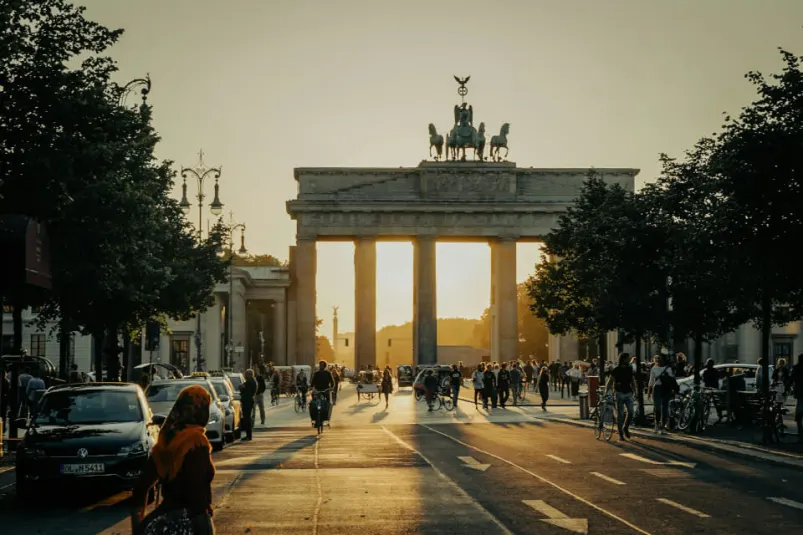5 Important Historical Monuments in Berlin

Berlin irritates, inspires, stumbles over its history, and rises again. Between glass facades, Wilhelminian gables suddenly appear, alongside empty spaces that have been deliberately left as they are. Official city guides count over 600 monuments, but numbers are only a backdrop here. Some places catch the eye, others are only noticed at second glance. Those who roam the city collect fragments of time, sometimes loudly, sometimes in passing.
The following five places outline royal splendor, abysses, and new beginnings. Their significance grows with each passing year as Berlin gains international attention as a city of remembrance.
1. Brandenburg Gate in the center of Berlin
The Brandenburg Gate stands in the middle of Pariser Platz, where the pavement always shines a little. Built between 1788 and 1791 according to plans by Carl Gotthard Langhans, it is topped by the Quadriga, which seems almost too obvious. For decades, the gate became a symbol of separation and then of reunification. Until 1989, it stood on the border strip, the so-called no man's land.
After the fall of the Berlin Wall, people flocked here, hundreds of thousands, perhaps more—the numbers vary. Today, the square is considered one of the most frequented places in the city, with estimates putting the number of passers-by at well over nine million a year. The building is a listed monument, and restoration work is carried out carefully and not without debate. Taking a photo here is somehow part of the experience for most people, and tour guides and reviews agree.
2. Memorial to the Murdered Jews of Europe
Between the Brandenburg Gate and Potsdamer Platz, the field of steles opens up. 2,711 gray concrete blocks, varying in height, covering 19,000 square meters, a grid that changes shape as you walk. Downstairs in the information center, names, stories, and families become visible, as far as they could be documented. The federal government provides a substantial amount of money for maintenance each year, most recently around 3.5 million euros.
Peter Eisenman, the architect, wanted to create irritation; no two steles are alike, and this still works today. Since 2005, many people have ranked the site as particularly impressive; groups of visitors prepare themselves, compare impressions, sometimes more than one might think. This memorial also shows the contrast between entertainment and serious remembrance culture.
3. The Berlin Victory Column in the Tiergarten
The Victory Column rises 67 meters high at the Großer Stern, originally erected in 1873 to commemorate the German-Danish War and later expanded in its symbolism. Every year, countless people climb the 285 steps, numbering just under a million according to estimates. At the top, a view over trees, avenues, and streets awaits. The gilded Victoria, long known locally as Goldelse, is said to weigh around 35 tons, and inside, music and lighting details are regularly adjusted by the responsible foundations.
Due to its location in the Tiergarten, the column serves as a marker for many major events, such as New Year's Eve, the marathon, and Pride. It also serves as a stage for protests, as was remembered in 2020 in the wake of Black Lives Matter. Postcards, feeds, photo collections—it appears again and again, almost like a Berlin reflex.
4. Berlin Wall Memorial on Bernauer Strasse
Bernauer Strasse has become a central place of remembrance of the division. Here stand 220 meters of the original wall, restored furnishings, the Hohenzollern crypt, an open-air exhibition, and the Chapel of Reconciliation. According to the memorial, hundreds of thousands of people visit every year, sometimes over 900,000, depending on how they are counted. Multimedia stations, eyewitness accounts, and special exhibitions make history more tangible for younger visitors, and sometimes more contradictory.
Funded by the state of Berlin, the foundation works to make learning inclusive. Questions of identity, separation, and unity come very close together here, almost physically between the remains of the Wall and the former death strip.
5. Berlin Cathedral on Museum Island
Berlin Cathedral rises at the edge of Museum Island, large and somewhat theatrical, which suits it well. Construction began in 1894 and was completed in 1905, with Julius Raschdorff drawing up the plans. At 98 meters high and with its striking dome, it is immediately visible from the Spree. Church guides report over 700,000 visitors a year, with an upward trend, many of them international.
Inside, the restored furnishings of the Hohenzollern crypt and a monumental organ that fills the room as soon as it sounds are impressive. Those who climb the 270 steps are rewarded with views of the TV tower, the Red Town Hall, the Humboldt Forum, and a city panorama in changing light. The cathedral moves between Prussian heritage, church practice, and contemporary culture, with concerts contributing to this. Perhaps it is precisely this mixture that keeps it alive.
There are many ways to explore history in Berlin.

Berlin Poche
Editorial Team
Always looking for new addresses, we like to share our discoveries and make you discover the best places in Berlin.